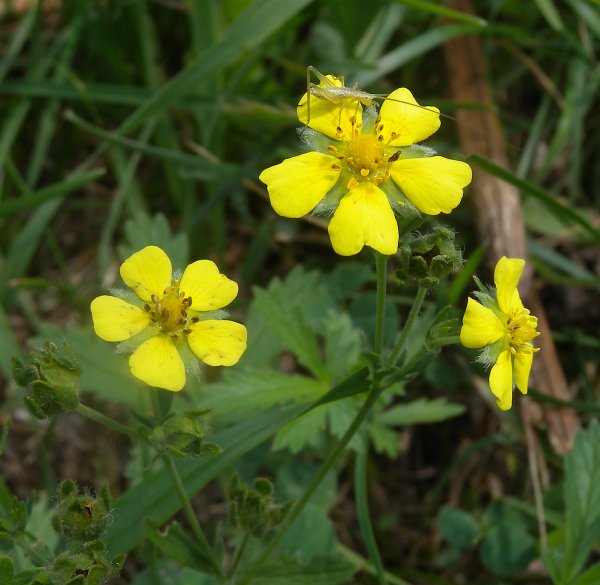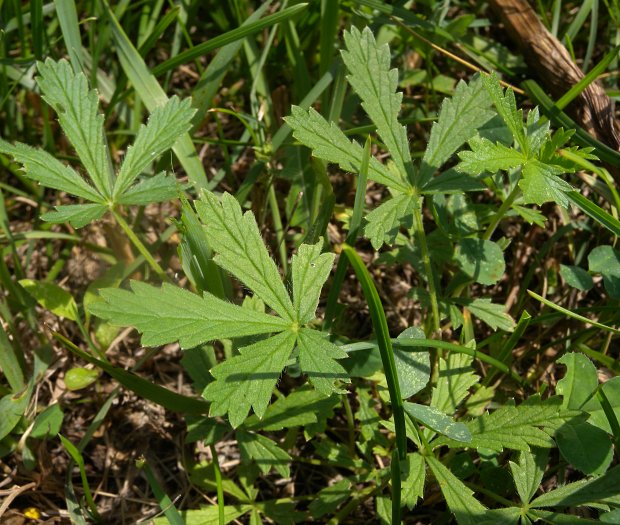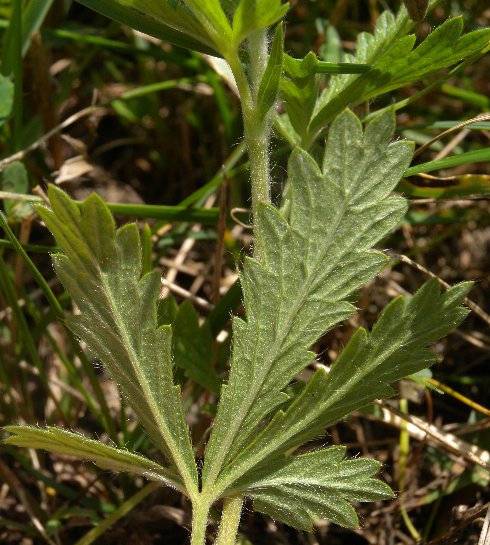Russian Cinquefoil
Potentilla intermedia
Rose family (Rosaceae)
Potentilla intermedia
Rose family (Rosaceae)
Description:
This herbaceous perennial plant is 8–22" (20–55 cm) long with leafy
stems that are sprawling, ascending, or erect. The stems are light to
medium green, branched or unbranched, terete (circular in
circumference), sparsely to moderately short-pubescent, and sometimes
sparsely
covered with sessile glands. Alternate leaves occur along the stems,
becoming smaller in size as they ascend. Some basal leaves may occur as
well. Lower alternate leaves are up to 4½" (11 cm.) long and 4" (10
cm.) across; they are usually palmate with 5 leaflets (less often
ternate with 3 leaflets). The petioles of the lower leaves are up to 5"
(12.5 cm.) long. Upper alternate leaves are smaller in size with
shorter petioles; they are usually ternate. For palmate leaves, the
terminal leaflets are largest in size while the lower lateral leaves
are smallest in size, and the arrangement of leaflet size is similar
for ternary leaves. The leaflets are mostly
oblanceolate (less often elliptic) with wedge-shaped bases and rounded
to bluntly tapered
tips; they are coarsely dentate along the upper half of their margins.
These margins are also sometimes ciliate. The upper surface of the
leaflets is
medium green and hairless to nearly hairless. The lower surface of the
leaflets is
pale grayish green below, sparsely hairy, sparsely canescent, and
sometimes sparsely covered with sessile glands. However, there tends to
be more
hairs along the lower ribs of the veins; these hairs are appressed. The
petioles of the leaves are light green to whitish green, narrowly
grooved above, and convex below; they are variably hairy and/or
short-pubescent. At the base of each petiole, there is a pair of leafy
stipules. These stipules are up to 1" (2.5 cm.) long and
linear-lanceolate to lanceolate in shape; otherwise, they are similar
to the leaflets.

The upper stems terminate in cymes or compound cymes of erect flowers. The size of these cymes and the number of their flowers are highly variable depending on the robustness of individual plants. Individual flowers are a little less than ½" (about 1 cm.) across, consisting of 5 spreading yellow petals, 5 light green sepals, 5 green floral bracts, and about 20 stamens surrounding a small ovoid cluster of golden yellow pistils (carpels). The petals are obovate to obcordate in shape; they are the same length or slightly longer than the sepals. The sepals are lanceolate-triangular to ovate-triangular in shape; they are hairy toward their tips above, hairy throughout below, and ciliate along their margins. The floral bracts are elliptic-lanceolate in shape and more narrow in shape than the sepals; they are usually a little shorter than the sepals. The floral bracts are hairy below and ciliate along their margins. The branches and pedicels of the inflorescence are light to medium green, terete, and short-pubescent; they often have narrow leafy bracts at their bases. Individual pedicels are ¼–1" (6–25 mm.) long. The blooming period occurs from early to mid-summer, lasting about 1 month. Afterwards, the flowers are replaced by small clusters of short-reniform achenes with short beaks. These achenes are about 1 mm. long. The root system has coarse fibrous roots that are brown; they are rather shallow. When a taproot is present, it is not well-defined. Sometimes shallow brown rhizomes are produced that can form clonal offsets.
Cultivation: The preference is full or partial sun, mesic to dry conditions, and gravelly or compacted soil with reduced competition. Most growth and develop occurs during the spring and early summer.

Range & Habitat: The non-native Russian Cinquefoil (Potentilla intermedia) is a rare weed in Illinois, having been reported from only 3 counties (see Distribution Map). However, it is probably more common within the state than official records indicate. Russian Cinquefoil has also been reported in other states, especially in the New England area, where it appears to be more common. This plant is native to Eurasia. In Illinois, habitats consist of gravelly roadsides, areas along railroads, edges of grassy paths with compacted soil, and waste areas. Habitats with a history of disturbance are preferred.
Faunal Associations: The flowers of Russian Cinquefoil (Potentilla intermedia) and other cinquefoils (Potentilla spp.) attract primarily small bees and flower flies (Syrphidae). Both nectar and pollen are available as floral rewards. Less common floral visitors include other flies, beetles, and small butterflies, especially the Cabbage Butterfly (Pieris rapae). Various insects are known to feed destructively on the flowers, stems, foliage, and other parts of cinquefoils, although little is know about Russia Cinquefoil specifically in North America. These insect feeders include the larvae of several gall wasps, various aphids, grasshoppers, a meadow katydid, a leaf beetle, and the larvae of a gall fly. The Insect Table lists these species for cinquefoils. Among vertebrate animals, White-tailed Deer browse the foliage of these plants and small rodents, like the Deer Mouse, eat small amounts of the seeds (Sotala & Kirkpatrick, 1973; Houtcooper, 1978). The seeds of cinquefoils are able to pass through the digestive tracts of deer and remain viable. As a result, these large animals help to spread the seeds to new locations.
Photographic Location: Edge of a compacted grassy path where a railroad used to occur at the Shortline Prairie in Champaign County, Illinois.

Comments: This is one of several cinquefoil species (Potentilla spp.) in Illinois. A few of these species are native, while others have been introduced from abroad. Distinguishing this species from other cinquefoil species is rather difficult, especially for the novice. Compared to the more common Sulphur Cinquefoil (Potentilla recta), Russian Cinquefoil differs by being a smaller plant (usually) with smaller flowers and smaller leaflets; these leaflets also have fewer teeth. Russian Cinquefoil also tends to be a less erect plant with fewer long hairs and more downy short hairs on its stems and leaflet undersides. Russian Cinquefoil differs from Rough Cinquefoil (Potentilla norvegica) by having some leaves with 5 leaflets, whereas the latter species has only 3 leaflets per leaf. The flowers of Russian Cinquefoil also have petals that are the same length or slightly longer than the underlying sepals, while the petals of Rough Cinquefoil are never longer than the sepals. A rare introduced species, Silver Cinquefoil (Potentilla argentea), differs from Russian Cinquefoil by having bright white leaflet undersides from short dense hairs, and the margins of its leaves have teeth that are more variable in size, less pointed at their tips, and often more deeply incised. Another rare introduced species, Grey Cinquefoil (Potentilla inclinata), is the most difficult cinquefoil species to distinguish from Russian Cinquefoil, possibly because they are both naturally occurring hybrids in Eurasia that share a parent species in common. Grey Cinquefoil differs by having slightly larger flowers, shorter floral bracts (about one-half of the length of its sepals), and the teeth along the margins of its leaflets tend to resemble those of Silver Cinquefoil, as described above. Other cinquefoil species that have been reported in the state have either a low stoloniferous habit of growth or they have pinnately arranged leaves with 5 or more leaflets, rather than ternate and/or palmate leaves. Other common names of Potentilla intermedia are Intermediate Cinquefoil and Downy Cinquefoil. For this species, the hairiness of individual plants, and the shape of their flower petals (oval to obcordate), can vary somewhat across local populations.

The upper stems terminate in cymes or compound cymes of erect flowers. The size of these cymes and the number of their flowers are highly variable depending on the robustness of individual plants. Individual flowers are a little less than ½" (about 1 cm.) across, consisting of 5 spreading yellow petals, 5 light green sepals, 5 green floral bracts, and about 20 stamens surrounding a small ovoid cluster of golden yellow pistils (carpels). The petals are obovate to obcordate in shape; they are the same length or slightly longer than the sepals. The sepals are lanceolate-triangular to ovate-triangular in shape; they are hairy toward their tips above, hairy throughout below, and ciliate along their margins. The floral bracts are elliptic-lanceolate in shape and more narrow in shape than the sepals; they are usually a little shorter than the sepals. The floral bracts are hairy below and ciliate along their margins. The branches and pedicels of the inflorescence are light to medium green, terete, and short-pubescent; they often have narrow leafy bracts at their bases. Individual pedicels are ¼–1" (6–25 mm.) long. The blooming period occurs from early to mid-summer, lasting about 1 month. Afterwards, the flowers are replaced by small clusters of short-reniform achenes with short beaks. These achenes are about 1 mm. long. The root system has coarse fibrous roots that are brown; they are rather shallow. When a taproot is present, it is not well-defined. Sometimes shallow brown rhizomes are produced that can form clonal offsets.
Cultivation: The preference is full or partial sun, mesic to dry conditions, and gravelly or compacted soil with reduced competition. Most growth and develop occurs during the spring and early summer.

Range & Habitat: The non-native Russian Cinquefoil (Potentilla intermedia) is a rare weed in Illinois, having been reported from only 3 counties (see Distribution Map). However, it is probably more common within the state than official records indicate. Russian Cinquefoil has also been reported in other states, especially in the New England area, where it appears to be more common. This plant is native to Eurasia. In Illinois, habitats consist of gravelly roadsides, areas along railroads, edges of grassy paths with compacted soil, and waste areas. Habitats with a history of disturbance are preferred.
Faunal Associations: The flowers of Russian Cinquefoil (Potentilla intermedia) and other cinquefoils (Potentilla spp.) attract primarily small bees and flower flies (Syrphidae). Both nectar and pollen are available as floral rewards. Less common floral visitors include other flies, beetles, and small butterflies, especially the Cabbage Butterfly (Pieris rapae). Various insects are known to feed destructively on the flowers, stems, foliage, and other parts of cinquefoils, although little is know about Russia Cinquefoil specifically in North America. These insect feeders include the larvae of several gall wasps, various aphids, grasshoppers, a meadow katydid, a leaf beetle, and the larvae of a gall fly. The Insect Table lists these species for cinquefoils. Among vertebrate animals, White-tailed Deer browse the foliage of these plants and small rodents, like the Deer Mouse, eat small amounts of the seeds (Sotala & Kirkpatrick, 1973; Houtcooper, 1978). The seeds of cinquefoils are able to pass through the digestive tracts of deer and remain viable. As a result, these large animals help to spread the seeds to new locations.
Photographic Location: Edge of a compacted grassy path where a railroad used to occur at the Shortline Prairie in Champaign County, Illinois.

Comments: This is one of several cinquefoil species (Potentilla spp.) in Illinois. A few of these species are native, while others have been introduced from abroad. Distinguishing this species from other cinquefoil species is rather difficult, especially for the novice. Compared to the more common Sulphur Cinquefoil (Potentilla recta), Russian Cinquefoil differs by being a smaller plant (usually) with smaller flowers and smaller leaflets; these leaflets also have fewer teeth. Russian Cinquefoil also tends to be a less erect plant with fewer long hairs and more downy short hairs on its stems and leaflet undersides. Russian Cinquefoil differs from Rough Cinquefoil (Potentilla norvegica) by having some leaves with 5 leaflets, whereas the latter species has only 3 leaflets per leaf. The flowers of Russian Cinquefoil also have petals that are the same length or slightly longer than the underlying sepals, while the petals of Rough Cinquefoil are never longer than the sepals. A rare introduced species, Silver Cinquefoil (Potentilla argentea), differs from Russian Cinquefoil by having bright white leaflet undersides from short dense hairs, and the margins of its leaves have teeth that are more variable in size, less pointed at their tips, and often more deeply incised. Another rare introduced species, Grey Cinquefoil (Potentilla inclinata), is the most difficult cinquefoil species to distinguish from Russian Cinquefoil, possibly because they are both naturally occurring hybrids in Eurasia that share a parent species in common. Grey Cinquefoil differs by having slightly larger flowers, shorter floral bracts (about one-half of the length of its sepals), and the teeth along the margins of its leaflets tend to resemble those of Silver Cinquefoil, as described above. Other cinquefoil species that have been reported in the state have either a low stoloniferous habit of growth or they have pinnately arranged leaves with 5 or more leaflets, rather than ternate and/or palmate leaves. Other common names of Potentilla intermedia are Intermediate Cinquefoil and Downy Cinquefoil. For this species, the hairiness of individual plants, and the shape of their flower petals (oval to obcordate), can vary somewhat across local populations.